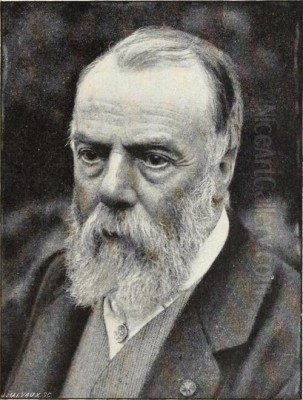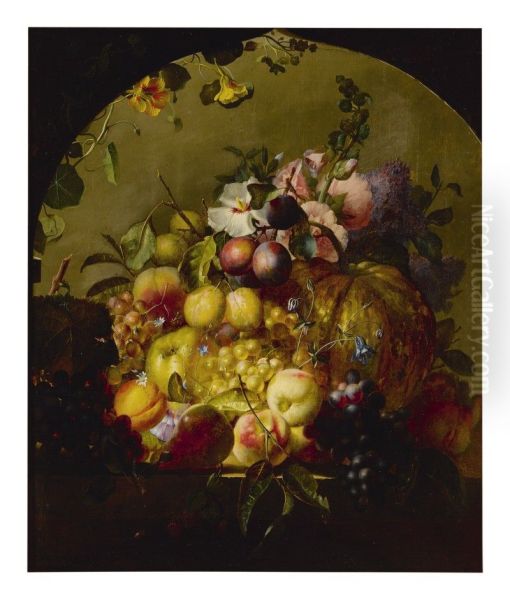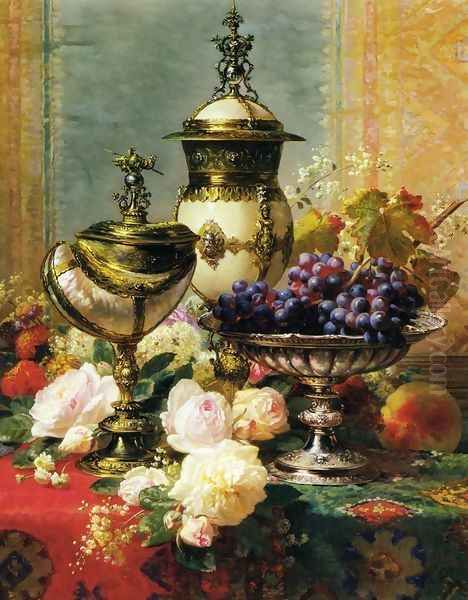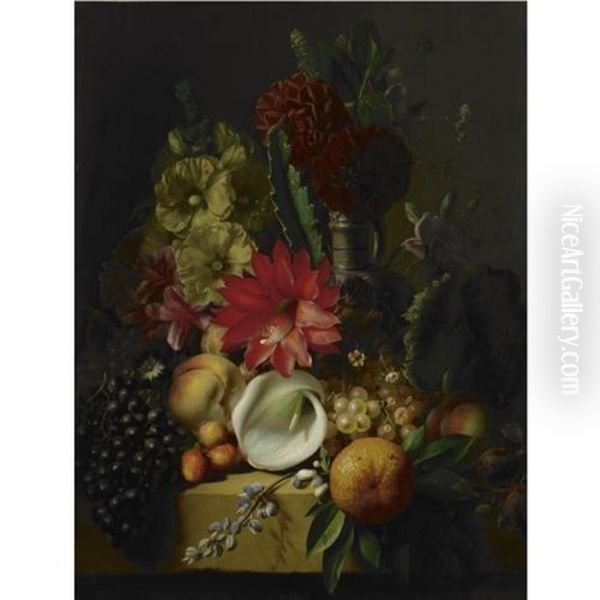
Jean-Baptiste Robie stands as a significant figure in nineteenth-century Belgian art. Born in Brussels in 1821 and living until 1910, his long career was primarily dedicated to the art of still life painting. He gained particular renown for his exquisite depictions of flowers and fruit, executed with remarkable detail and a vibrant sense of colour. His specialization, particularly in rendering roses, earned him the affectionate title "Master of Roses," cementing his reputation as a leading practitioner of the genre in his time. Robie skillfully blended traditional techniques with a modern sensibility, contributing significantly to the revival of still life painting during a period often dominated by other artistic movements.
Early Life and Artistic Formation
Jean-Baptiste Robie entered the world on November 19, 1821, in Brussels, the heart of Belgium. His origins were modest; his father worked as a blacksmith, placing the family within the working class of the city. Despite these humble beginnings, Robie harboured artistic ambitions. Initially, he pursued his passion through self-study, honing his skills independently before seeking formal training.
His dedication led him to the prestigious Académie Royale des Beaux-Arts in Brussels. There, he had the opportunity to study under the guidance of Balthazar-François Tasson, a respected Belgian painter known for his own work in landscape and still life. This formal education provided Robie with a solid foundation in academic techniques, complementing his innate talent.
An interesting footnote to his early career involves portraiture. It is reported that Robie initially painted portraits of Napoleon Bonaparte. These were apparently created for British tourists visiting the nearby battlefield of Waterloo, serving as souvenirs of the famous historical site. This early commercial endeavour contrasts sharply with the refined still lifes that would later define his artistic identity, showcasing an early pragmatism alongside his developing artistry.
Development of a Signature Style

After his initial foray into portraiture, Jean-Baptiste Robie found his true calling in still life. He gravitated towards the intricate beauty of the natural world, focusing predominantly on flowers and fruit. His canvases soon became celebrated for their meticulous detail, luminous quality, and rich, yet realistic, colour palettes. He possessed an extraordinary ability to capture the delicate textures of petals, the sheen on fruit, and the play of light across surfaces.
His particular affinity for roses became a hallmark of his work. He depicted them with such frequency and skill – capturing different varieties, colours, and stages of bloom – that he became widely known as the "Master of Roses." This title reflected not just his technical prowess but also his deep appreciation for the flower's form and symbolism.
Robie's style drew clear inspiration from the masters of the Dutch Golden Age of the seventeenth century, artists renowned for their detailed and often symbolic still lifes. Figures like Jan Fyt and Jan van Kessel the Elder, known for their opulent floral and faunal compositions, represent the tradition Robie looked towards. However, Robie did not merely imitate. He adapted this legacy, infusing it with a nineteenth-century sensibility, often characterized by brighter palettes and perhaps a less overtly moralizing tone than some earlier Dutch works. He modernized the tradition, creating works that felt both timeless and contemporary to his audience.
Major Works and Themes
Throughout his prolific career, Jean-Baptiste Robie created numerous still life paintings that captivated audiences. While a comprehensive list is extensive, several works exemplify his style and thematic concerns. Still Life with Roses and Raspberries showcases his delicate touch, balancing the softness of the flowers with the vibrant red of the fruit in a composition described as quiet and light. It highlights his profound understanding of floral painting.
Another example, Still Life with a Vase of Flowers, demonstrates his technical mastery in arranging complex bouquets and rendering the reflective surfaces of a vase. Works titled generally, like Fruit, Flowers and Precious Objects, point to a recurring theme in his oeuvre: the combination of natural bounty with man-made luxury items. These paintings often feature elaborate cups, glassware, or fabrics alongside the meticulously painted fruit and flowers, creating a sense of opulence and refined taste.

A Vase of Roses and a Tankard on a Table combines his favoured floral subject with a rustic or perhaps antique element, showcasing his ability to create interesting textural contrasts. Similarly, Still Life with Roses and a Blue Tit by a Stream introduces a touch of wildlife, integrating the bird naturally into the floral setting and hinting at a broader harmony between flora and fauna. Though sometimes venturing into landscape and seascape, the core of his output remained these detailed, often abundant, still lifes celebrating cultivated nature and aesthetic beauty.
Exhibition Career and Recognition
Jean-Baptiste Robie's artistic journey was marked by consistent public exhibition and growing acclaim. He made his debut at the prestigious Brussels Salon in 1843, an important venue for Belgian artists to showcase their work and gain recognition. This marked the beginning of a long relationship with the Salon, where he exhibited regularly over the subsequent decades, with documented participation in years such as 1848, 1854, 1860, 1863, 1867, 1875, and 1876.
His reputation extended beyond Belgium's borders. Robie also submitted works to the highly influential Paris Salon, the epicentre of the art world in the nineteenth century. Success in Paris was crucial for international recognition, and Robie achieved this, further solidifying his standing. His meticulously crafted still lifes found favour with critics and collectors alike.
This growing esteem was reflected in the official honours bestowed upon him. In 1861, he was made a Knight of the Order of Leopold, a significant Belgian order of merit. His international recognition was acknowledged in 1869 when he was appointed a Chevalier (Knight) of the French Legion of Honour. Further accolades followed in Belgium, where he was promoted to Officer of the Order of Leopold in 1881, and later reportedly achieved the rank of Commander in 1885. These honours underscore the high regard in which Robie was held by both the Belgian state and the international art community. His reputation steadily grew in Belgium, France, and even reached across the Atlantic to the United States.
Travels and Broadening Horizons
Beyond the studio and exhibition halls, Jean-Baptiste Robie was an avid traveller. His journeys took him far and wide across Europe, including extended visits to Italy, Spain, France, Germany, and the United Kingdom. His wanderlust did not stop at the continent's edge; he ventured further afield, exploring the landscapes and cultures of the Middle East – including Egypt, Syria, and Palestine – and travelling as far as India.

These extensive travels profoundly impacted Robie, both personally and artistically. Experiencing diverse cultures and environments broadened his perspectives and provided fresh inspiration. While he remained primarily devoted to still life, his travels occasionally influenced his subject matter. Some accounts suggest an interest in Oriental themes may have appeared in his work, likely inspired by his experiences in the Middle East and India.
Furthermore, his travels likely contributed to his exploration of other genres, albeit less frequently than still life. He is known to have painted landscapes and seascapes, potentially capturing scenes encountered on his journeys. Robie was not just a visual observer during his travels; he was also a writer. He authored several books recounting his travel experiences, sharing his observations and artistic reflections with a wider audience, adding another dimension to his multifaceted career.
Artistic Context and Contemporaries
Jean-Baptiste Robie's career unfolded during a dynamic period in European, and particularly Belgian, art history. He worked in the long shadow of the Flemish Baroque masters like Peter Paul Rubens and Anthony van Dyck, whose influence permeated Belgian art for centuries. However, the nineteenth century saw significant shifts. French movements like Romanticism and Realism exerted considerable influence, turning attention towards contemporary life, social issues, and landscape. In Belgium, artists like Constantin Meunier gained prominence for their powerful depictions of industrial labourers and peasant life, reflecting the era's growing social consciousness.
While Robie was contemporary to these developments, his artistic path diverged. He focused on reviving and refining the genre of still life, drawing more from seventeenth-century traditions than from the burgeoning modern movements like Impressionism, which was developing concurrently through artists like Camille Pissarro and Alfred Sisley (students of the landscape painter Jean-Baptiste-Camille Corot). Robie's dedication to meticulous realism and traditional subject matter set him apart from the avant-garde.
Within the realm of still life, however, he was a leading figure. He is often discussed alongside prominent French still life painters of the era, such as Antoine Vollon and Philippe Rousseau, who also contributed to the genre's resurgence in the nineteenth century. While direct collaboration records might be scarce, these artists operated within the same artistic niche, likely aware of each other's work and contributing to a shared dialogue around still life painting. Robie also maintained connections within the Belgian art scene, counting the painter Theodore Fourmois among his friends and having studied under Balthazar-François Tasson.
Legacy and Collections
Jean-Baptiste Robie left behind a legacy as one of Belgium's foremost still life painters of the nineteenth century. His dedication to the genre, particularly his mastery in depicting flowers, ensured his enduring reputation long after his death in 1910. His work is praised for its technical brilliance, exquisite detail, vibrant colour, and the sheer aesthetic pleasure it provides. He successfully navigated the line between honouring the rich tradition of Dutch and Flemish still life and creating works that appealed to the tastes of his own time.
His paintings found their way into numerous important public and private collections across Europe and North America. Notable institutions reported to hold his works include the Victoria and Albert Museum in London, which houses his Flowers in a decorated vase and fruit in an elegant cup, and the Metropolitan Museum of Art in New York. The presence of his art in such prestigious museums attests to its quality and historical significance. His works continue to appear at auction houses, demonstrating sustained interest from collectors.
Robie played a crucial role in the nineteenth-century revival of still life painting. In an era focused on grand historical narratives, landscape, and the burgeoning movements of modernism, he upheld the value of intimate observation and the celebration of natural beauty. His focus on cultivated nature, rendered with precision and elegance, offered a counterpoint to other artistic trends and ensured the continued vitality of the still life tradition.
Conclusion
Jean-Baptiste Robie's life and work represent a dedicated pursuit of beauty through the meticulous art of still life. From his humble beginnings in Brussels, he rose through talent and perseverance to become an internationally recognized artist, celebrated particularly as the "Master of Roses." His technical skill, honed through academic training and refined over decades, allowed him to capture the delicate intricacies of flowers and fruit with unparalleled realism and vibrancy.
While deeply influenced by the Golden Age of Dutch and Flemish painting, Robie was not merely an imitator; he adapted these traditions for a nineteenth-century audience, creating works of enduring appeal. His extensive travels broadened his horizons, and his consistent participation in major Salons secured his reputation. Honoured by both Belgium and France, his legacy is preserved in major museum collections and continues to be appreciated by art lovers today. Jean-Baptiste Robie remains a testament to the enduring power of still life painting and a significant figure in the rich tapestry of Belgian art history.